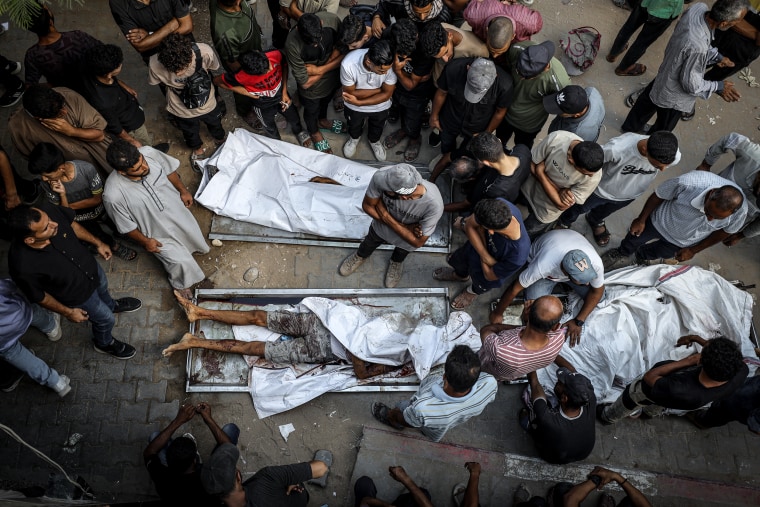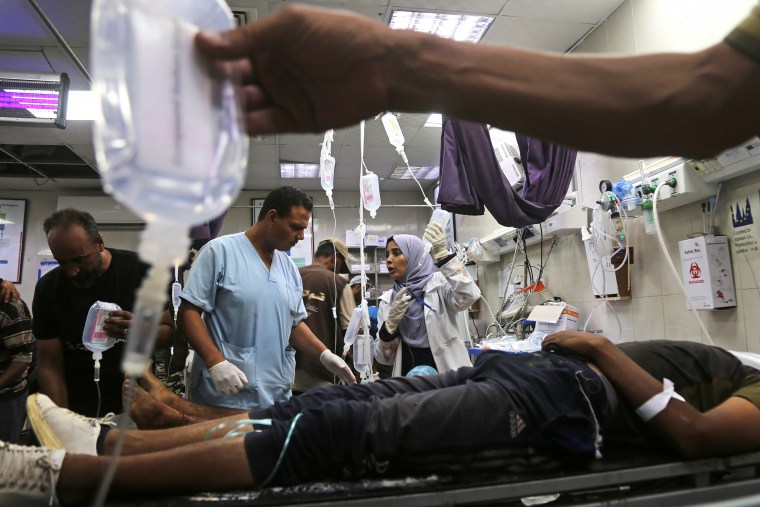A pair of American volunteer doctors described to NBC News a barely coping hospital in Gaza, with bodies spread across the blood-smeared floors as medical staff struggled to treat hundreds of people who had been injured as they tried to access humanitarian aid.
“We have children who are dead on the floor and we are unable to move these patients just due to the sheer volume that we received,” Ahmed Farhat, an emergency physician from California, told NBC News in a video message Tuesday, talking about the situation at the Nasser Medical Complex in the city of Khan Younis.
“We have patients who are intubated on the floor with no sedation. We have patients who have chest tubes on the floor, patients who are bleeding out,” added Farhat, who is just under two weeks into a medical mission run by the Michigan-based Rahma Worldwide, a charity founded in 2014 that operates emergency response and humanitarian relief programs across the Middle East and Africa.
His comments echo those of other doctors working in Gaza who in recent interviews with NBC News have lamented the lack of food and medicine being allowed into the enclave, amid international outrage over widespread starvation and deaths from malnutrition. Others have described aid distribution points as death traps, as a growing number of people have been killed or injured while seeking desperately needed food.

Three short videos taken by Farhat in the Nasser Medical Complex on Tuesday showed dozens of people waiting for treatment on the hospital’s floors. Some had tubes inserted to help them breathe, others were motionless.
Citing hospital administration data, Farhat said in a text message on Wednesday that the Nasser Complex received 453 patients within a number of hours on Tuesday, and 48 of them had died.
He added that his patients told him they had come under fire by Israeli forces while trying to collect aid from two sites run by the Gaza Humanitarian Foundation, the U.S. and Israel-backed organization that has been mired in controversy since replacing most United Nations-run relief operations in Gaza in May.

In a statement to NBC News on Wednesday, the GHF, which operates four militarized food aid distribution sites across the enclave in areas where the Israeli military is active, said aid convoys belonging to the United Nations and other organizations in the past often passed near their locations and were regularly looted by large crowds.
However, it said there were “no incidents at or near” their sites on Tuesday. A spokesperson for the United Nations Office for the Coordination of Humanitarian Affairs (OCHA) could not confirm whether its aid convoys had been looted near GHF sites.
NBC News has reached out to the Israeli military for comment about the casualties at Nasser Hospital.
Farhat said other patients had told him they had been fired upon in another incident near Gaza’s southernmost city of Rafah while seeking aid from a United Nations aid convoy that was passing through.
An OCHA spokesperson did not have any details about the specific event, but said such incidents are not uncommon.
Separately, the Health Ministry in Hamas-run Gaza said Wednesday that 87 people had been killed and 570 injured in a series of incidents across the enclave on Tuesday.
Travis Melin, an anesthesiologist from Oregon who also volunteers at the Nasser Hospital, said the number of patients on Tuesday had been “huge.” In a text message Wednesday, he added that he had seen the highest number of casualties at the hospital during his monthlong tenure there.
“We’re still doing emergency surgery on people who should have gone to the OR yesterday,” he said.
The “worst-case scenario of famine” is unfolding in the Gaza Strip under Israel’s assault, the world’s leading body on hunger said last week. Meanwhile, most of its residents have been driven from their homes and more than 61,000 killed, including thousands of children, according to local health officials. Israel launched its offensive in Gaza following the Hamas-led Oct. 7, 2023, terror attacks in which some 1,200 people were killed and around 250 taken hostage.
Nearly 1,400 people have been killed and more than 4,000 injured while seeking food, the United Nations’ OCHA said in an update Tuesday. “At least 859 people have been killed around GHF sites since the beginning of GHF’s operations,” it added.
Source link
 Unews World
Unews World
